
"Streamlining Your Zoom Recordings A Comprehensive Workshop for 2024"

Streamlining Your Zoom Recordings: A Comprehensive Workshop
Are you thinking of making your podcasts but worried about how to record them? Chill, you don’t need a professional studio for this purpose. There is a lot of software, but zoom podcast recording is relatively more straightforward. A podcast is a collection of audio files that you can either download or listen to online using the internet. This article will help you learn to record podcasts using zoom.
7-Step Formula: How To Record a Podcast on Zoom?
Recording a podcast on zoom is quite simple and easy. You don’t need to be a recording expert; you can get it done at home using your laptop. In this article, I will guide you on how to record a podcast using zoom step by step.
Step1 Download and Install
The 1st step is downloading and installing zoom on your device. Next, create your zoom account by visiting the zoom website . Log in to this account with your installed software and enjoy zoom free. The free version allows you to record for 40 minutes. For longer calls, purchase the paid version.
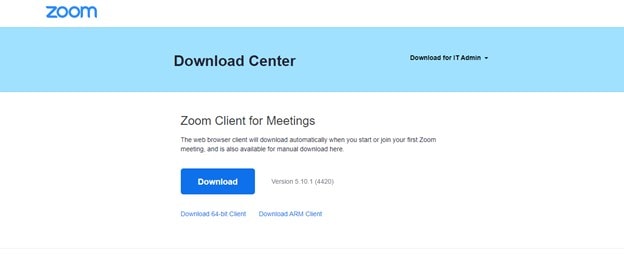
Step2 Setting Up Microphone and Headphones
Zoom can use your device’s built-in microphone, but it is advised to use a high-quality external mic. It enhances the quality of your podcast tremendously. Plenty of external mics are available for under 50$, which can make a real difference.
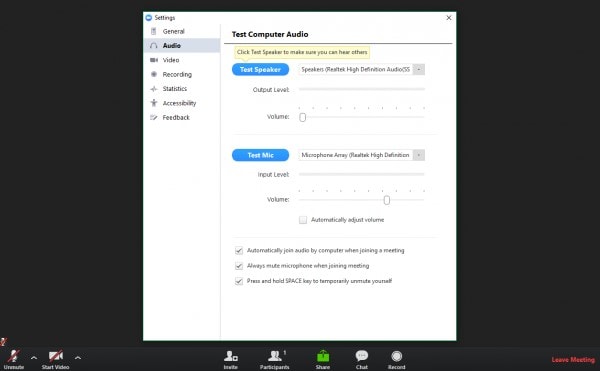
Step3 Eliminate Any Background Noise
No one is interested in listening to what’s happening in the background while listening to your podcast. So, before pressing the ‘Record’ button, ensure your environment is as quiet as possible. You can take the following steps to reduce background noises.
- Turn off the fan, air conditioner, or any other noisy appliances.
- Remove noisy kids, roommates, or pets.
- Hang a ‘Do Not Disturb’ sign on your front door.
- Shut your door and windows to avoid noise from outside sources, such as sirens, traffic horns, etc.
- Avoid the rustling sound of paper or moving things around your desk.
- Install noise-canceling software to filter out any background noise.
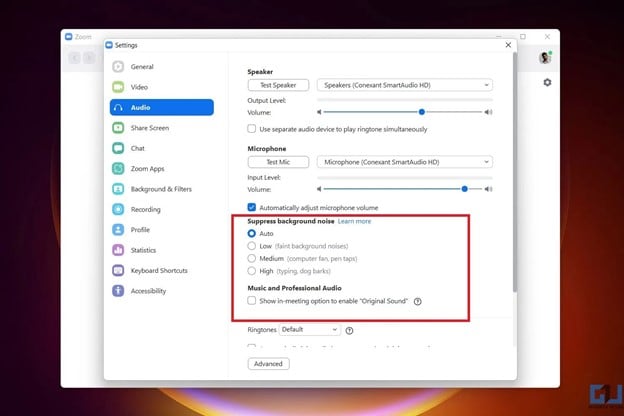
Step4 Set Up Separate Audio Tracks for Each Speaker
Wouldn’t it be easier to edit your podcast if you recorded audio tracks for each speaker separately? Zoom has this feature of recording separate audio tracks.
To enable this, go to your zoom ‘Settings’ and click on the ‘Recording’ setting. Then select “Record a separate audio file for each participant,” and you are ready to go.
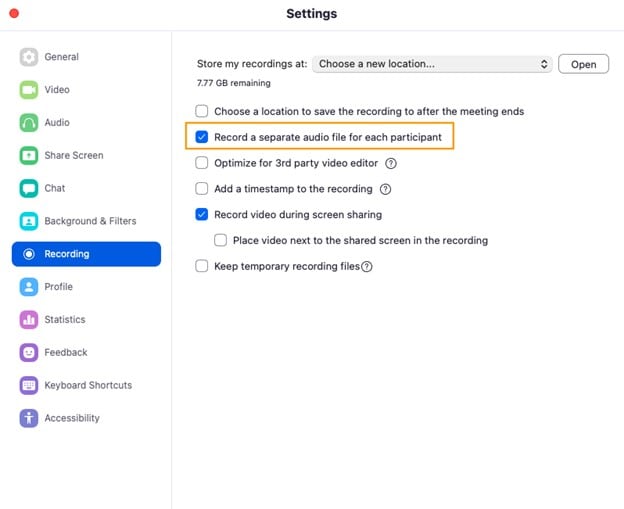
Step5 Brief Your Guest About Zoom Functioning Before You Begin
If you are going live and your guest is new to zoom, it is better that you guide him briefly about the functioning of zoom. Guide your guest on how to join the call using zoom. It would be best if you also told him about the duration and topic of your podcast.
It is advised to test the microphone and headphones of your guest before starting a live podcast. Your guest does not need to download and install zoom on their device; he can join by clicking the link and entering the call from his browser.
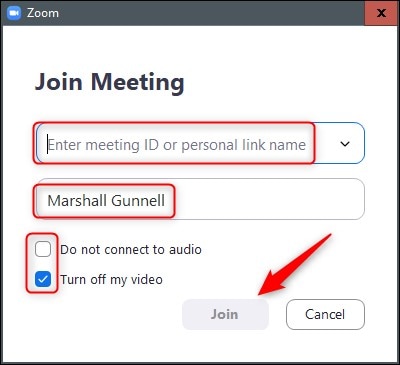
Step6 Record the Call Using Zoom
It is pretty simple to record a podcast using zoom. Here are the steps you need to follow:
- Click on the ‘New Meeting’ button to initiate the call.
- Now click on the ‘Invite’ button.
- Select ‘Copy Invitation’ and copy the ID and password of your meeting
- Share the ID and passcode with your guest.
- Ask your guest to join the call by clicking on the link.
- After your guest joins the call, press ‘Manage Participants’ at the bottom of the screen.
- You will see a list of all the participants. Please make sure everyone’s microphone is working and their voices are clear.
- Click on the participant name you want to make a co-host and press the make co-host button.
- Click the ‘Record’ button and turn on ‘Original Sound’ to start recording the podcast.
- When the podcast is complete, click on the ‘End’ button and then click on ‘End Meeting for All.’
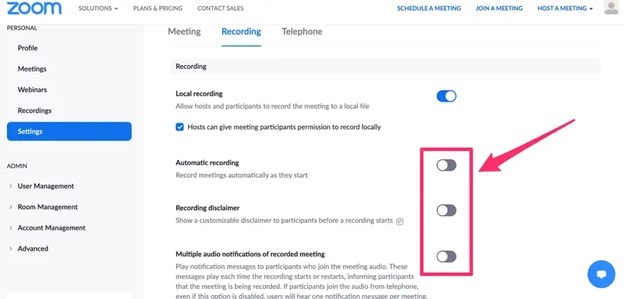
Step7 Edit the Audio File Using Editing Tools
At the end of the recording session, you will get two different file types. An MP4 audio file that you can edit using audio editors and an MP4 video file that you can edit and post on youtube or any other social media platform.
If you have recorded separate audio tracks for each speaker, you will get separate MP4 audio files for each speaker with that person’s name. You can edit the audio tracks with professional podcast editing software, like Audacity editor or Filmora.
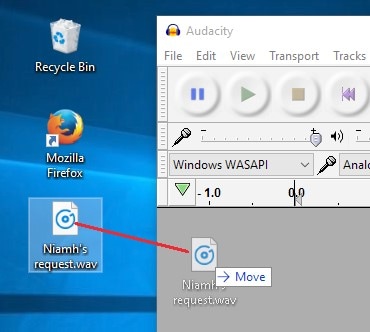
We have discussed how to use zoom for recording podcasts, and now we will look at the benefits of using zoom to record podcasts.
The Benefits of Using Zoom To Record Your Podcasts
- You can host any podcast on zoom- a solo one where you are the speaker, hosting a speaker, or co-hosting with another podcaster.
- Co-host with anyone you want with a particular social distancing meanwhile.
- Share the screen with the attendees in just a few clicks.
- Built-in feature splits audio and video and makes editing much more accessible.
- Can accommodate multiple participants when there are more speakers
- The audience may feel more involved in the discussion.
Limitations of Using Zoom for Podcasts
Having discussed the method to record podcasts with zoom and the benefits of using zoom, we will now discuss the limitations of zoom for podcast recording. Of course, every software has its limits, and so does zoom, and these limitations are discussed below.
● Audio and Video Quality
Zoom’s priority is virtual conferencing, which compromises audio and video quality to optimize the speed and smoothness of calling. Besides, the recording audio and video quality depend upon your internet speed. If your internet is slow, you will experience lag and interruptions in your recorded podcasts.
● Compressed Audio and Video
Zoom compresses your audio and video files by removing portions of audio tracks making the file smaller. Audio compression makes your video chat smooth, but the resulting recorded file is of low quality for professional use.
● Time limit
With the free plan, you can make calls for a maximum of 40 minutes. To record longer podcasts, you must spend money on the paid version.
Tips to Elevate Your Podcast With Zoom
- Ensure you and your guest have a strong and stable internet connection.
- Give your guest a brief tutorial on zoom before going live.
- Use a high-quality podcast microphone for better audio quality.
- Make sure your environment is quiet, and there is no background noise.
- Use your device’s built-in video recorder to record a backup podcast. It will be helpful if your internet lags and in case you somehow lose the zoom recording.
Because of its limitations, zoom cannot be used as a professional podcast recording tool. So we need an alternative to zoom to record podcasts for professional purposes, and here Wondershare Filmora comes into play.
The Best Zoom Alternative – Wondershare Filmora Recording With No Quality Loss
Wondershare Filmora can record screen and webcam simultaneously and also can capture the system and microphone audio at the same time. As a result, it is one of the most powerful video recording software that can record any activity on your PC screen.
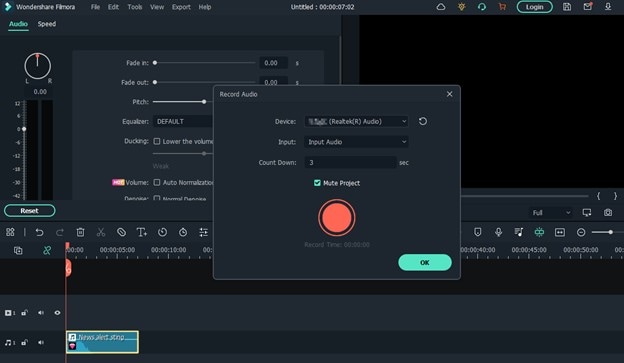
With Wonderhsare Filmora, you can easily record podcasts, gameplays, lectures, and many other videos with no quality loss and export the videos to youtube and Vimeo.
Features
The following are some audio editing features of Filmora.
- Over 2000+ audio resources range from music, audio effects and much more.
- Convert your written files to voiceover using the Text-to-Speech feature. It is the best for podcasters who don’t want to use their voice.
- Support speech-to-text that allows smooth conversion of voiceover to text.
- Audio Ducking to quickly eliminate background noise and unwanted sound recorded while creating podcasts.
- Create eye-catchy podcast videos by adding adorable animations using an advanced keyframing tool.
Recording From Webcam and Editing Podcast With Filmora
Recording from a Webcam and editing podcasts have been made much easier and simpler by Filmora. It is an easy-to-use software and comes with amazing editing features.
Steps to Record From Webcam
Now we will discuss step by step how you can record from a webcam using Wondershare Filmora.
Step1 Download and Install Filmora
The first step is to download and install Filmora on your desktop. To download Wondershare Filmora , go to their official website and start downloading from there. After downloading, install Filmora on your device.
Step2 Launch Filmora
After installing, left-click on the Filmora icon twice to launch it. The Wondershare Filmore user interface will open on the screen.

Step3 Screen Recorder’s Settings Panel
Open the Filmora recorder settings and make the following adjustments.
1. Dimension Settings
You can set the dimensions you want to record your desktop screen. This way, you will get fine recorded footage according to your needs.

2. Setting up Microphone
If you want to record audio with the desktop screen, click on the microphone icon to turn on the audio recording. Keep the microphone off if you want to record your device screen only.
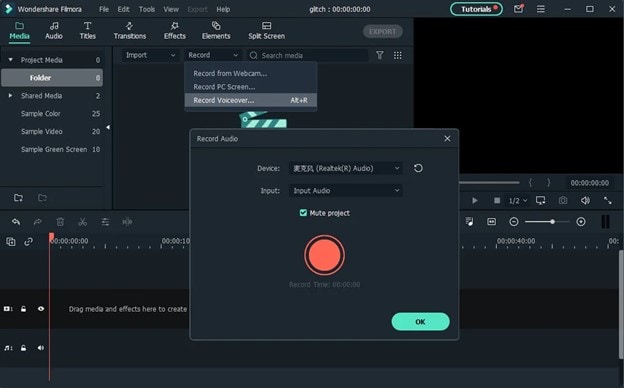
3. Speaker Audio and Webcam
If you wish to record both device’s audio and screen, keep the Speaker Audio Recorder in its default ON position.
Similarly, for the Webcam option, click on the icon to allow screen recording or keep it disabled if you don’t want to record the screen.
4. Parameter Adjustment
Set the frame rate, quality, and screen record timer before starting. Also, select the destination folder of your recorded file.
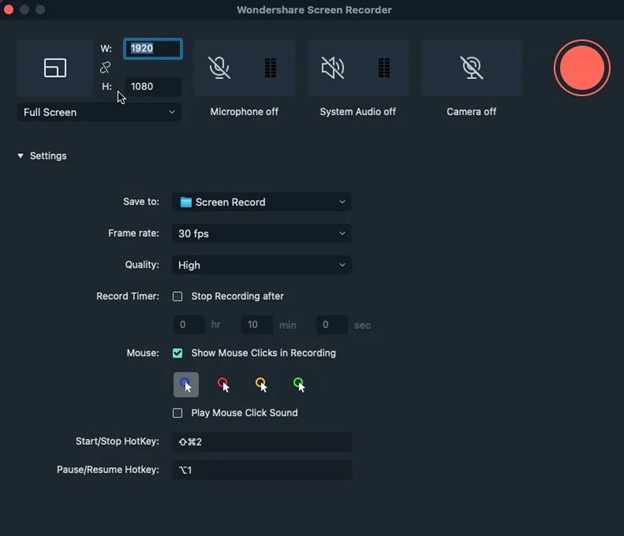
Steps to Edit Podcast With Filmora
Once you have recorded the podcast, the next step is to edit it before posting it on youtube or any other social media platform. Again, Filmora, with its fantastic editing features, is the software of choice for this purpose.
Its effects and transitions can make a real difference, and here I will show how you can edit podcasts with Filmora step-by-step.
Step1 Import the Audio Track
The first step in editing a podcast is to import the audio track in Filmora. Then, you can drag and drop the audio track to import it into the Filmora.
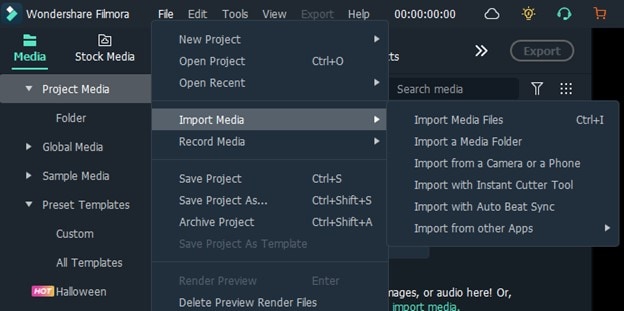
Step2 Listen Again And Remove Background noises
Before proceeding further, don’t forget to re-listen to your added audio track. This re-listening will help you decide which part you want to keep and delete the other part. Remove any background hiss using different noise reduction tools.
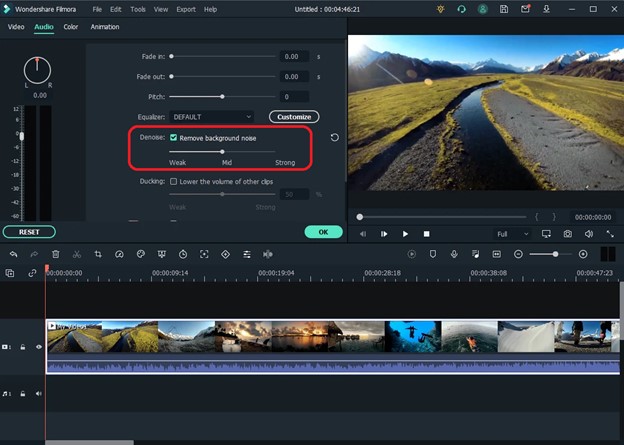
Step3 Make Audio Consistent Throughout
The next step after removing background noise is to make the volume consistent throughout the podcast. Select -2.0 level for peak amplitude and amplify the low amplitude areas.
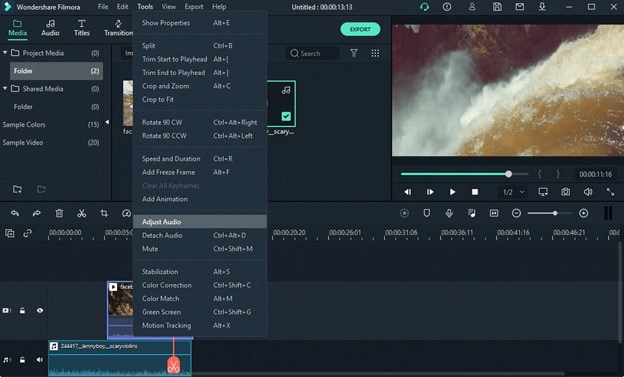
Step4 Add Effects and Transitions
The next step is to do sound designing and mix the podcast. Add different effects and transitions. Always try to add such effects that increase the audience’s interest and keep the audience engaged. Finally, compress and equalize the audio to adjust it accordingly in different sections of the podcast.
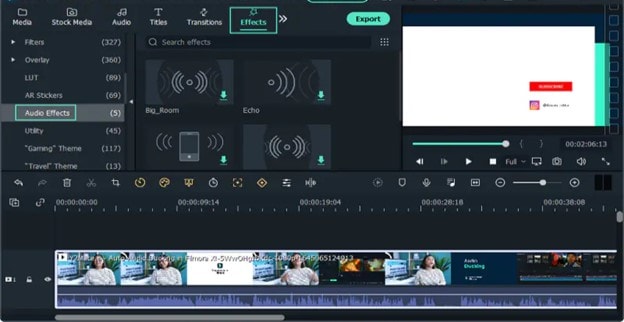
Step5 Preview, Export, and Post on Social Media
Once you complete your podcast editing, preview it to check if everything is in its place. If you want to make any other changes, this is the time. After you are satisfied, click the ‘Export Button’ to export your podcast. After exporting, you can post it on youtube or any other social media platform.
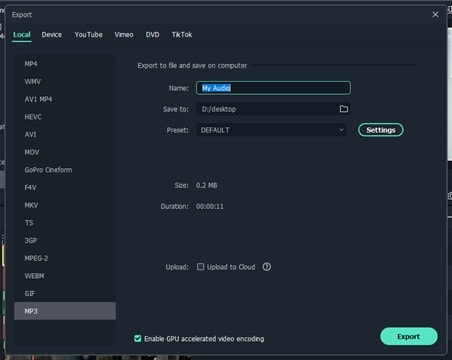
If you still have questions about the podcast audio editing process, you can look at the complete video tutorial below.
How to EDIT AUDIO in Filmora 11
Hot FAQs on Zoom Podcasts Recording
1. Can you record a podcast virtually?
Yes, a podcast can be recorded virtually using suitable software and equipment, such as a microphone and headphones. A noise-free environment is also crucial for recording a podcast.
Zoom is the most cost-effective, straightforward, and reliable software to record your podcast. You can use the built-in feature of zoom to record your conference calls and use them for podcasting purposes.
2. Are Zoom recorders good for podcasts?
Zoom makes it very simple for you to record podcasts, whether it is a solo podcast or a group discussion. Its features, such as a built-in recorder and separate audio tracks for each speaker, make it great for podcasting. But you can’t use it for professional purposes because it compresses the audio files and reduces their quality.
3. How do I host a podcast on Zoom?
After installing zoom on your device, sign in to zoom. Create a meeting ID and passcode and invite people to your podcast by sending them the meeting ID and passcode. People can also join your meeting directly by clicking the link you provide. After people join your meeting, you can host a podcast. If you want to publish your podcast, you can start recording it from settings, edit it, and post it.
Final Words
In this article, we learned that recording and editing podcasts using suitable software is pretty straightforward. Zoom is ideal for hosting and recording podcasts for beginners.
Zoom alternatives such as Wondershare Filmora can be used to record podcasts for more professional use. In addition, Filmora can record a podcast in much better quality. Another advantage of preferring Filmora over zoom is its editing capability.
Edit your recorded podcast using Filmora’s unique transitions and effects and post it on youtube, Vimeo, or any other social media platform.
If you find this information helpful, share it with your podcaster friends and if you have any queries, leave a comment below.
Free Download For Win 7 or later(64-bit)
Free Download For macOS 10.14 or later
Free Download For macOS 10.14 or later
Also read:
- [New] 2024 Approved Discord Profile Video Info Dimensions, Codec, Time Span
- [New] Ensuring Clear Audio in Remote Recording
- [New] The Right Path to Precise Speech-to-Text with Google App for 2024
- [Updated] 2024 Approved Sewn Sequences Learning Loom Screen Casting
- [Updated] Complete Razer Kiyo Webcam Overview
- [Updated] Fading Sounds Gently A Guide to Softening Audibility in Lumafusion
- [Updated] In 2024, Expert Choice List Ultimate Streaming Audio Gear
- [Updated] Unleashing Video Potential Effective SEO Strategies for YouTube
- 2024 Approved Cinematic Clips Reviewed Best in the Business
- 9 Best Phone Monitoring Apps for Lava Blaze 2 | Dr.fone
- Android Safe Mode - How to Turn off Safe Mode on Motorola Edge 2023? | Dr.fone
- How to get back lost photos from Spark 20 Pro+.
- HP Z440 Support: Find and Update Essential System Drivers Here
- Mastering The Fix: WSL Registration Failure with Error X80370102
- Movavi - Trasforma I Tuoi File TGA in Un Momento Con Il Loro Servizio Gratuito Online
- Title: Streamlining Your Zoom Recordings A Comprehensive Workshop for 2024
- Author: Catherine
- Created at : 2024-12-22 20:42:57
- Updated at : 2024-12-29 00:48:35
- Link: https://desktop-recording.techidaily.com/streamlining-your-zoom-recordings-a-comprehensive-workshop-for-2024/
- License: This work is licensed under CC BY-NC-SA 4.0.